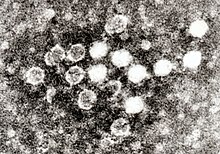Amdoparvovirus is a genus of viruses in the family Parvoviridae in the subfamily Parvovirinae. Mustelids, skunk, and raccoons serve as natural hosts. There are five species in this genus. Diseases associated with this genus include progressive disorder of immune system.
Bocaparvovirus is a genus of viruses in the subfamily Parvovirinae of the virus family Parvoviridae. Humans, cattle, and dogs serve as natural hosts. There are 28 species in this genus. Diseases associated with this genus include, in humans, acute respiratory illness, and in cattle, diarrhea and mild respiratory symptoms.

Protoparvovirus is a genus of viruses in the Parvovirinae subfamily of the virus family Parvoviridae. Vertebrates serve as natural hosts. There are 15 species in the genus including Rodent protoparvovirus 1 for which the exemplar virus is minute virus of mice (MVM). This genus also includes canine parvovirus (CPV), which causes gastrointestinal tract damage in puppies that is about 80% fatal, and porcine parvovirus (PPV), which is a major cause of fetal death and infertility in pigs. The genus divides phylogenetically into two branches, one that contains many founder members of the family, such as MVM, CPV and PPV, which have been studied in considerable detail, and a second branch occupied exclusively by predicted viruses whose coding sequences were identified recently in the wild using virus discovery approaches, but whose biology remains minimally explored. This second branch currently contains two species whose members infect humans, called Primate protoparvovirus 1 and Primate protoparvovirus 3. Until 2014, the genus was called Parvovirus, but it was renamed to eliminate confusion between members of this genus and members of the entire family Parvoviridae.
Betapapillomavirus is a genus of viruses, in the family Papillomaviridae. Human serve as natural hosts. There are six species in this genus. Diseases associated with this genus include warts, papilloma, and malignant tumours.
Brevihamaparvovirus is a genus of viruses in subfamily Hamaparvovirinae of the family Parvoviridae. Mosquitoes serve as natural hosts. There are two species in this genus.
Deltapapillomavirus is a genus of viruses, in the family Papillomaviridae. Ruminants serve as natural hosts. There are seven species in this genus. Diseases associated with this genus include: warts of the skin and alimentary tract ; possibly responsible for the skin tumour equine sarcoid in horses and donkeys.
Epsilonpapillomavirus is a genus of viruses, in the family Papillomaviridae. Cattle serve as natural hosts and it is one of the bovine papillomaviruses. There are two species in this genus. Diseases associated with this genus include: fibropapillomas and true epithelial papillomas of the skin.
Iotapapillomavirus is a genus of viruses, in the family Papillomaviridae. Rodents serve as natural hosts. There are two species in this genus. Diseases associated with this genus include: cutaneous lesions and benign skin tumours, such as papillomas and keratoacanthomas.
Iteradensovirus is a genus of viruses in the subfamily Densovirinae of the family Parvoviridae. Insects serve as natural hosts. There are five species in this genus.
Lambdapapillomavirus is a genus of viruses, in the family Papillomaviridae. Cats and dogs serve as natural hosts. There are five species in this genus. Diseases associated with this genus include: mucosal and cutaneous lesions.
Omikronpapillomavirus is a genus of viruses, in the family Papillomaviridae. Porpoises serve as natural hosts. There is only one species in this genus: Omikronpapillomavirus 1. Diseases associated with this genus include: causes genital warts.
Percavirus is a genus of viruses in the order Herpesvirales, in the family Herpesviridae, in the subfamily Gammaherpesvirinae. Mammals serve as natural hosts. There are six species in this genus. Diseases associated with this genus include: conjunctivitis, immunosuppression in foals, pneumonia, respiratory disease.
Pipapillomavirus is a genus of viruses, in the family Papillomaviridae. Hamsters serve as natural hosts. There are two species in this genus. Diseases associated with this genus include: cutaneous lesions.
Thetapapillomavirus is a genus of viruses, in the family Papillomaviridae. Birds serve as natural hosts. There is only one species in this genus: Thetapapillomavirus 1. Diseases associated with this genus include cutaneous lesions.
Xipapillomavirus is a genus of viruses, in the family Papillomaviridae. Bovine serve as natural hosts. There are five species in this genus. Diseases associated with this genus include: true papillomas on the cutaneous or mucosal surfaces of cattle.
Zetapapillomavirus is a genus of viruses, in the family Papillomaviridae. Horses serve as natural hosts. There is only one species in this genus: Zetapapillomavirus 1. Diseases associated with this genus include: cutaneous lesions.
Aveparvovirus is a genus of viruses, in the subfamily Parvovirinae of the virus family Parvoviridae. There are three species in this genus. Diseases associated with this genus include: enteric disease and malabsorption syndrome.
Copiparvovirus is a genus of viruses in subfamily Parvovirinae of the virus family Parvoviridae. Pigs and cows are known to serve as natural hosts. There are seven species in this genus.
Hepanhamaparvovirus is a genus of viruses that belongs to the Hapanhamavirinae subfamily of the family Parvoviridae. Insects and shrimps serve as natural hosts. Infection leads to mortality in the early larval and postlarval stages of the shrimp. There is only one species in this genus: Decapod hepanhamaparvovirus 1.
Penstylhamaparvovirus is the name of a genus of viruses in the subfamily Hamaparvovirinae of the virus family Parvoviridae. Shrimps and insects serve as natural hosts. There is only one species in this genus: Decapod penstylhamaparvovirus 1.

